| |
LEGEND:
 |
 |
|
Link to a PDF document |
 |
 |
|
Link to non-governmental site and does not
necessarily represent the views of the CDC |

|
 |
| Adobe
Acrobat (TM) Reader needs to be installed on
your computer in order to read documents in PDF format.
Download the Reader.
|
|
 |
 |
 |

| 
|
HIV
Mortality
(through 2005) |
 |
 |
|
Instructions for downloading and using
HIV/AIDS surveillance slides. Download the
complete slide set:
While the content is in the public domain and
no copyright restriction applies,
we do ask that users preserve the slides in
their current format and cite CDC as the
source.
|

Slide 3
Comparison of Mortality Data from
AIDS Case Reports and Death Certificates
in Which HIV Disease Was Selected as the
Underlying Cause of Death, United
States, 1987−2005
PDF
File
 or
PPT
File or
PPT
File |
|

Slide 4
Trends in Annual Age-Adjusted Rate
of Death due to HIV Disease, United States, 1987−2005
PDF
File
 or
PPT
File or
PPT
File |
|

Slide 5
Trends in Annual Age-Adjusted Rate of Death
due to HIV Disease, by Sex, United States, 1987−2005
PDF
File
 or
PPT
File or
PPT
File |
|

Slide 6
Trends in the Percentage Distribution of Deaths due to HIV Disease, by Sex, United States, 1987−2005
PDF
File
 or
PPT
File or
PPT
File |
|
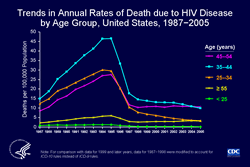
Slide 7
Trends in Annual Rates of Death due to
HIV Disease, by Age Group, United
States, 1987−2005
PDF
File
 or
PPT
File or
PPT
File |
|
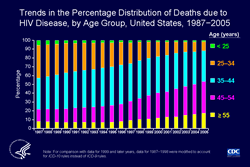
Slide 8
Trends in the Percentage
Distribution of Deaths due to HIV
Disease, by Age Group, United States,
1987−2005
PDF
File
 or
PPT
File
or
PPT
File |
|

Slide 9
Median Age at Death due to HIV
Disease United States, 1987–2005
PDF
File
 or
PPT
File or
PPT
File |
|

Slide 10
Age-Adjusted Rate of Death due to HIV
Disease, by State, United States, 2005
PDF File
 or
PPT
File
or
PPT
File |
|

Slide 11
Trends in Age-Adjusted Annual Rates
of Death due to HIV Disease, by
Geographic Region, United States,
1987−2005
PDF
File
 or
PPT
File or
PPT
File |
|
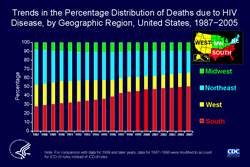
Slide 12
Trends in the Percentage
Distribution of Deaths due to HIV
Disease, by Geographic Region, United
States, 1987−2005
PDF
File
 or
PPT
File or
PPT
File |
|
![Slide #13 - Title:
Trends in Age-Adjusted* Annual Rates of Death due to HIV Disease, by Race/Ethnicity, United States, 1990−2005
The age-adjusted rate of death due to HIV disease has been highest among non-Hispanic blacks and second highest among Hispanics.
In every racial/ethnic group, the rate decreased greatly from 1995 through 1998. Among non-Hispanic blacks, however, the percentage decrease in the rate was proportionally smaller (58%) than in the other racial/ethnic groups. The percentage decrease in the other groups ranged from 67% among American Indians/Alaska Natives to 76% among non-Hispanic whites.
In the absence of information from the next-of-kin, some American Indians/Alaska Natives, and Asians/Pacific Islanders may have been misclassified as white, which could have resulted in underestimation of death rates in these groups.
[Technical Notes: For the calculation of national death rates by race and ethnicity, data for a few states were excluded for the years when death certificates for those states did not collect information on Hispanic ethnicity. The states for which data were omitted were: Connecticut and Louisiana in 1990, New Hampshire through 1992, and Oklahoma through 1996.]](images/Slide13.gif)
Slide 13
Trends in Age-Adjusted Annual Rates
of Death due to HIV Disease, by
Race/Ethnicity, United States, 1990−2005
PDF
File
 or
PPT
File or
PPT
File |
|
![Slide #14 - Title:Trends in the Percentage Distribution of Deaths due to HIV Disease, by Race/Ethnicity, United States, 1990−2005
From 1990 through 2005, the proportion of non-Hispanic blacks among persons who died of HIV disease increased from 29% to 55%, while the proportion of non-Hispanic whites decreased from 53% to 30%. This shift in the racial/ethnic distribution of deaths accelerated from 1996 through 1998, coincident with the increasing use of highly active antiretroviral therapy, suggesting that the shift may have resulted in part from differential access to the therapy. The proportion of Hispanics was stable at 13% to 14%, and the proportion of persons in other racial/ethnic groups (including Asians/Pacific Islanders, and American Indians/Alaska Natives) was stable at about 1%. In addition, the proportion of persons of unspecified race/ethnicity decreased from 4% to 1%.
[Technical Notes: For the calculation of the national percentage of deaths by race and ethnicity, data for a few states were excluded for the years when death certificates for those states did not collect information on Hispanic ethnicity. The states for which data were omitted were: Connecticut and Louisiana in 1990, New Hampshire through 1992, and Oklahoma through 1996.]](images/Slide14.gif)
Slide 14
Trends in the Percentage
Distribution of Deaths due to HIV
Disease, by Race/Ethnicity, United
States, 1990−2005
PDF
File
 or
PPT
File or
PPT
File |
|
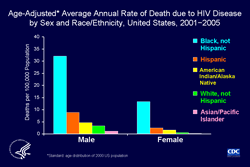
Slide 15
Age-Adjusted Average Annual Rate of Death due to HIV Disease, by Sex and Race/Ethnicity, United States, 2001−2005
PDF
File
 or
PPT
File or
PPT
File |
|
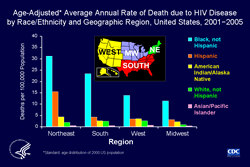
Slide 16
Age-Adjusted Average Annual Rate of Death due to HIV Disease
by Race/Ethnicity and Geographic Region, United States, 2001−2005
PDF
File
 or
PPT
File or
PPT
File |
|
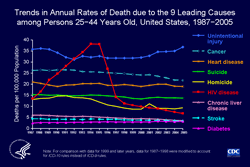
Slide 17
Trends in Annual Rates of Death due
to the 9 Leading Causes among Persons
25−44 Years Old, United States,
1987−2005
PDF
File
 or
PPT
File or
PPT
File |
|
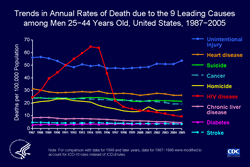
Slide 18
Trends in Annual Rates of Death due
to the 9 Leading Causes among Men 25−44
Years Old, United States, 1987−2005
PDF
File
 or
PPT
File or
PPT
File |
|
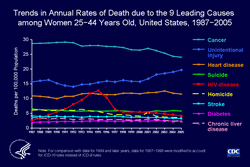
Slide 19
Trends in Annual Rates of Death due
to the 9 Leading Causes among Women
25−44 Years Old, United States,
1987−2005
PDF
File
 or
PPT
File or
PPT
File |
|
![Slide #20 - Title:
Trends in Annual Rates of Death due to the 9 Leading Causes among White, not Hispanic Men 25−44 Years Old, United States, 1990−2005
Among non-Hispanic white men 25 to 44 years of age, the rate of death due to HIV disease reached a peak in 1994, when HIV was the 2nd leading cause of death, accounting for almost 14,000 deaths, or 21% of all deaths in this demographic group. The rate of death due to HIV fell during 1996 and 1997, after which HIV was the 5th leading cause of death except in 2001, when homicide rose to 5th place because of the terrorist attacks on September 11. In 2005, HIV caused about 1,300 deaths, or 3% of all deaths in this group.
[Technical Notes: For the calculation of national death rates by race and ethnicity, data for a few states were excluded for the years when death certificates for those states did not collect information on Hispanic ethnicity. The states for which data were omitted were: Connecticut and Louisiana in 1990, New Hampshire through 1992, and Oklahoma through 1996].](images/Slide20.gif)
Slide 20
Trends in Annual Rates of Death due
to the 9 Leading Causes among White, not
Hispanic Men 25−44 Years Old, United
States, 1990−2005
PDF
File
 or
PPT
File or
PPT
File |
|
![Slide #21 - Title:
Trends in Annual Rates of Death due to the 8 Leading Causes and HIV among White, not Hispanic Women 25−44 Years Old United States, 1990−2005
Among non-Hispanic white women 25 to 44 years of age, the rate of death due to HIV disease peaked in 1995, when HIV was the 5th leading cause of death, accounting for more than 1,300 deaths, or almost 5% of all deaths in this demographic group. The rate of death due to HIV dropped during 1996 and 1997, after which HIV was either the 10th or 11th leading cause of death. In 2005, HIV caused fewer than 400 deaths, or 1% of all deaths in this group.
[Technical Notes: For the calculation of national death rates by race and ethnicity, data for a few states were excluded for the years when death certificates for those states did not collect information on Hispanic ethnicity. The states for which data were omitted were: Connecticut and Louisiana in 1990, New Hampshire through 1992, and Oklahoma through 1996.]](images/Slide21.gif)
Slide 21
Trends in Annual Rates of Death due
to the 8 Leading Causes and HIV among
White, not Hispanic Women 25−44 Years
Old United States, 1990−2005
PDF
File
 or
PPT
File or
PPT
File |
|
![Slide #22 - Title:
Trends in Annual Rates of Death due to the 9 Leading Causes among Black, not Hispanic Men 25−44 Years Old, United States, 1990−2005
From 1990 through 1999, HIV disease was the most common cause of death among non-Hispanic black men 25 to 44 years of age. The rate of death due to HIV peaked in 1995, when HIV caused more than 9,000 deaths, or 34% of all deaths in this demographic group. The rate of death due to HIV dropped rapidly from 1996 through 1998, and more slowly thereafter. HIV was the 4th leading cause of death in 2005, when it caused about 1,900 deaths, or 11% of all deaths in this group.
[Technical Notes: For the calculation of national death rates by race and ethnicity, data for a few states were excluded for the years when death certificates for those states did not collect information on Hispanic ethnicity. The states for which data were omitted were: Connecticut and Louisiana in 1990, New Hampshire through 1992, and Oklahoma through 1996.]](images/Slide22.gif)
Slide 22
Trends in Annual Rates of Death due
to the 9 Leading Causes among Black, not
Hispanic Men 25−44 Years Old, United
States, 1990−2005
PDF
File
 or
PPT
File or
PPT
File |
|
![Slide #23 - Title:
Trends in Annual Rates of Death due to the 9 Leading Causes among Black, not Hispanic Women 25−44 Years Old, United States, 1990−2005
From 1993 through 1996, HIV disease was the most common cause of death among non-Hispanic black women 25 to 44 years of age. The rate of death due to HIV peaked in 1995, when HIV caused more than 3,000 deaths, or 23% of all deaths in this demographic group. The rate of death due to HIV dropped rapidly in 1996 and 1997, after which HIV disease was the 3rd leading cause of death. In 2005, HIV caused about 1,200 deaths, or 11% of all deaths in this group.
[Technical Notes:For the calculation of national death rates by race and ethnicity, data for a few states were excluded for the years when death certificates for those states did not collect information on Hispanic ethnicity. The states for which data were omitted were: Connecticut and Louisiana in 1990, New Hampshire through 1992, and Oklahoma through 1996.]](images/Slide23.gif)
Slide 23
Trends in Annual Rates of Death due
to the 9 Leading Causes among Black, not
Hispanic Women 25−44 Years Old, United
States, 1990−2005
PDF
File
 or
PPT
File or
PPT
File |
|
![Slide #24 - Title:
Trends in Annual Rates of Death due to the 9 Leading Causes among Hispanic Men 25−44 Years Old, United States, 1990−2005
From 1993 through 1996, HIV disease was the most common cause of death among non-Hispanic black women 25 to 44 years of age. The rate of death due to HIV peaked in 1995, when HIV caused more than 3,000 deaths, or 23% of all deaths in this demographic group. The rate of death due to HIV dropped rapidly in 1996 and 1997, after which HIV disease was the 3rd leading cause of death. In 2005, HIV caused about 1,200 deaths, or 11% of all deaths in this group.
[Technical Notes:For the calculation of national death rates by race and ethnicity, data for a few states were excluded for the years when death certificates for those states did not collect information on Hispanic ethnicity. The states for which data were omitted were: Connecticut and Louisiana in 1990, New Hampshire through 1992, and Oklahoma through 1996.]](images/Slide24.gif)
Slide 24
Trends in Annual Rates of Death due
to the 9 Leading Causes among Hispanic
Men 25−44 Years Old, United States,
1990−2005
PDF
File
 or
PPT
File or
PPT
File |
|
![Slide #25 - Title:
Trends in Annual Rates of Death due to the 9 Leading Causes among Hispanic Women 25−44 Years Old, United States, 1990−2005
Among Hispanic women 25 to 44 years of age, HIV disease was the second most common cause of death from 1992 through 1996. The rate of death due to HIV peaked in 1995, when HIV caused almost 800 deaths, or 21% of all deaths in this demographic group. The rate of death due to HIV dropped rapidly in 1996 and 1997, and more slowly afterward. HIV disease was the 5th leading cause of death in 2005, when it caused about 200 deaths, or 4% of all deaths in this group.
[Technical Notes: For the calculation of national death rates by race and ethnicity, data for a few states were excluded for the years when death certificates for those states did not collect information on Hispanic ethnicity. The states for which data were omitted were: Connecticut and Louisiana in 1990, New Hampshire through 1992, and Oklahoma through 1996.]](images/Slide25.gif)
Slide 25
Trends in Annual Rates of Death due
to the 9 Leading Causes among Hispanic
Women 25−44 Years Old, United States,
1990−2005
PDF
File
 or
PPT
File or
PPT
File |
|
![Slide #26 - Title:
Trends in Annual Rates of Death due to the 9 Leading Causes among Asian/Pacific Islander Men 25−44 Years Old United States, 1990−2005
Among Asian/Pacific Islander men 25 to 44 years of age, the rate of death due to HIV disease peaked in 1994, when HIV was the 4th leading cause, accounting for more than 200 deaths, or 13% of all deaths in this demographic group. The rate of death due to HIV dropped rapidly in 1996 and 1997, and more slowly from 1998 through 2005. In 2005, HIV was the 8th leading cause of death, accounting for 34 deaths, or 2% of all deaths in this group.
[Technical Notes: For the calculation of national death rates by race and ethnicity, data for a few states were excluded for the years when death certificates for those states did not collect information on Hispanic ethnicity. The states for which data were omitted were: Connecticut and Louisiana in 1990, New Hampshire through 1992, and Oklahoma through 1996.]](images/Slide26.gif)
Slide 26
Trends in Annual Rates of Death due
to the 9 Leading Causes among
Asian/Pacific Islander Men 25−44 Years
Old United States, 1990−2005
PDF
File
 or
PPT
File or
PPT
File |
|
![Slide #27 - Title:
Trends in Annual Rates of Death due to the 9 Leading Causes among Asian/Pacific Islander Men 25−44 Years Old United States, 1990−2005
Among Asian/Pacific Islander women 25 to 44 years of age, the rate of death attributed to HIV disease peaked in 1994, when HIV was the 7th leading cause of death, accounting for 24 deaths, or less than 2% of all deaths in this demographic group. The rate of death due to HIV fell during 1995 through 1997. In 2005, HIV caused only 7 deaths, or less than 1% of all deaths in this group. During the entire period, the rate of death due to HIV was unstable and statistically unreliable because of small numbers (ranging from 5 to 24 deaths per year). The rank of HIV disease among causes of death was likewise unstable, jumping from 16th in 2001 to 12th in 2005.
[Technical Notes: For the calculation of national death rates by race and ethnicity, data for a few states were excluded for the years when death certificates for those states did not collect information on Hispanic ethnicity. The states for which data were omitted were: Connecticut and Louisiana in 1990, New Hampshire through 1992, and Oklahoma through 1996.]](images/Slide27.gif)
Slide 27
Trends in Annual Rates of Death due
to the 9 Leading Causes among
Asian/Pacific Islander Men 25−44 Years
Old United States, 1990−2005
PDF
File
 or
PPT
File or
PPT
File |
|
![Slide #28 - Title:
Trends in Annual Rates of Death due to the 9 Leading Causes among American Indian/Alaska Native Men 25−44 Years Old United States, 1990−2005
Among American Indian/Alaska Native men 25 to 44 years of age, unintentional injury was the most common cause of death, responsible for about one third of all deaths − three times as many deaths as the second leading cause, suicide. The rate of death due to unintentional injury decreased substantially during the 1990s but increased in 2002, followed by a drop in 2003 and 2004 and an increase in 2005. The rate of death due to HIV disease peaked in 1995, when HIV was the 3rd leading cause of death, accounting for more than 100 deaths, or 10% of all deaths in this group. HIV infection was the 7th leading cause of death from 1997 through 2004. In 2005, HIV was the 8th leading cause of death, when it caused 25 deaths, or 2% of all deaths in this group. The rates of deaths due to diabetes and stroke were statistically unreliable because of small numbers (fewer than 20 per year).
[Technical Note: For the calculation of national death rates by race and ethnicity, data for a few states were excluded for the years when death certificates for those states did not collect information on Hispanic ethnicity. The states for which data were omitted were: Connecticut and Louisiana in 1990, New Hampshire through 1992, and Oklahoma through 1996.]](images/Slide28.gif)
Slide 28
Trends in Annual Rates of Death due
to the 9 Leading Causes among American
Indian/Alaska Native Men 25−44 Years Old
United States, 1990−2005
PDF
File
 or
PPT
File or
PPT
File |
|
![Slide #29 - Title:
Trends in Annual Rates of Death due to the 9 Leading Causes and HIV among American Indian/Alaska Native Women 25−44 Years Old United States, 1990−2005
Among American Indian/Alaska Native women 25 to 44 years of age, the rate of death due to HIV disease peaked in 1995, when HIV was the 7th leading cause of death, accounting for 20 deaths, or 4% of all deaths in this demographic group. In 2005, HIV was the 9th leading cause of death, accounting for only 16 deaths, or 3% of all deaths in this group. The rates of death due to HIV disease, stroke, and diabetes during the entire period were statistically unreliable because of small numbers (20 or fewer per year).
[Technical Notes: For the calculation of national death rates by race and ethnicity, data for a few states were excluded for the years when death certificates for those states did not collect information on Hispanic ethnicity. The states for which data were omitted were: Connecticut and Louisiana in 1990, New Hampshire through 1992, and Oklahoma through 1996.]](images/Slide29.gif)
Slide 29
Trends in Annual Rates of Death due
to the 9 Leading Causes and HIV among
American Indian/Alaska Native Women
25−44 Years Old United States, 1990−2005
PDF
File
 or
PPT
File or
PPT
File |
|
|
|
|